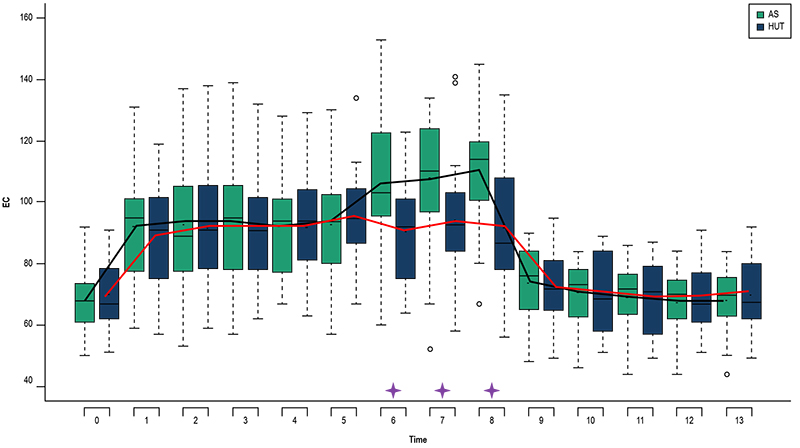Volume 110, Nº 1, January 2018
DOI: http://www.dx.doi.org/10.5935/abc.20180003
ORIGINAL ARTICLE
Cardiac and Musculoskeletal Responses to the Effects of Passive and Active Tilt Test in Healthy Subjects
Rogerio Ferreira Liporaci
Marcelo Camargo Saad
Julio César Crescêncio
Fabiana Marques
Debora Bevilaqua-Grossi
Lourenço Gallo-Júnior

Figure 1 – Heart rate behavior during the Active Standing Test (AS) and the Head-Up Tilt Test (HUT). : Mean variation of heart rate during AS. : Mean variation of heart rate during AS. : Significant difference between AS and HUT; p < 0.05. Heart rate in beats per minute (bpm).
Abstract
Background: Maintenance of orthostatism requires the interaction of autonomic and muscle responses for na efficient postural control, to minimize body motion and facilitate venous return in a common type of syncope called neurocardiogenic syncope (NCS). Muscle activity in standing position may be registered by surface electromyography, and body sway confirmed by displacement of the center of pressure (COP) on a force platform. These peripheral variables reflect the role of muscles in the maintenance of orthostatism during the active tilt test, which, compared with muscle activity during the passive test (head-up tilt test), enables the analyses of electromyographic activity of these muscles that may anticipate the clinical effects of CNS during these tests.
Objective: to evaluate and compare the effects of a standardized protocol of active and passive tests for CNS diagnosis associated with the effects of Valsalva maneuver (VM).
Methods: twenty-thee clinically stable female volunteers were recruited to undergo both tests. EMG electrodes were placed on muscles involved in postural maintenance. During the active test, subjects stood on a force platform. In addition to electromyography and the platform, heart rate was recorded during all tests. Three VMs were performed during the tests.
Results: progressive peripheral changes were observed along both tests, more evidently during the active test.
Conclusion: the active test detected changes in muscle and cardiovascular responses, which were exacerbated by the VM. (Arq Bras Cardiol. 2018; 110(1):74-83)
Keywords: Syncope, Vasovagal; Heart Rate; Postural Balance; Tilt Table Test.















